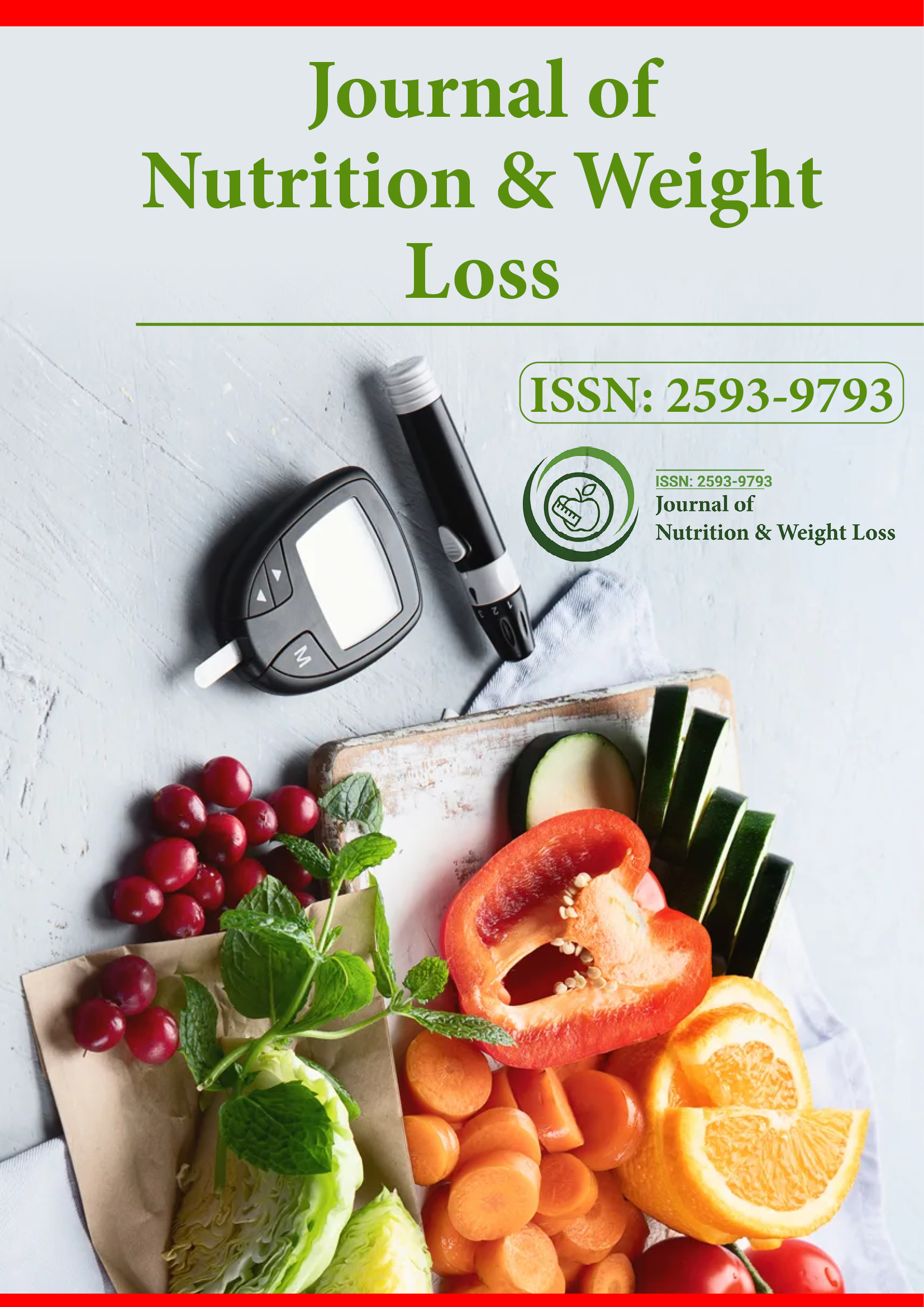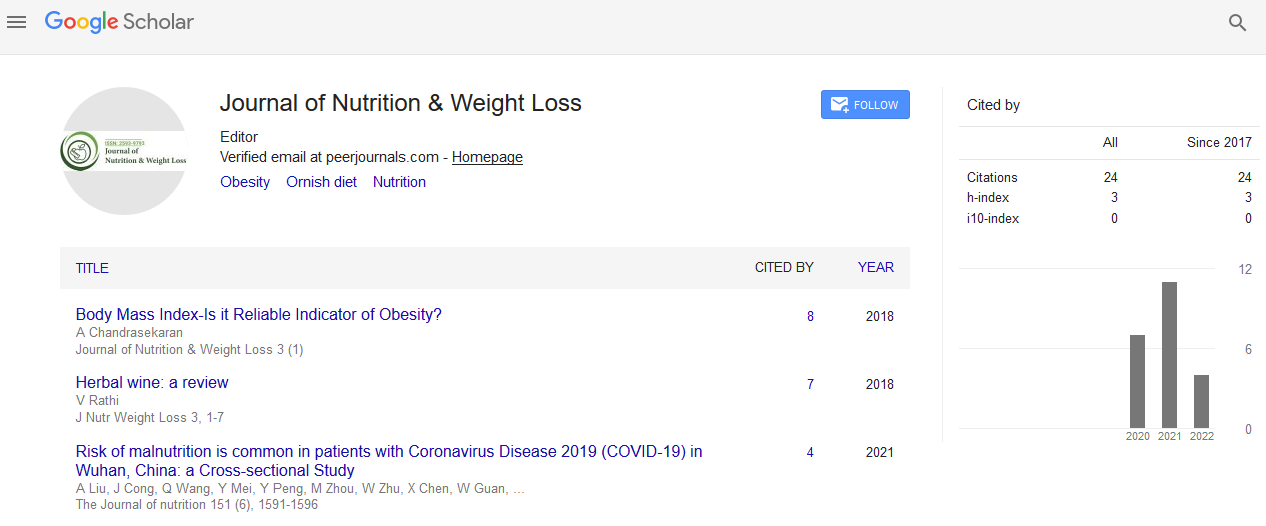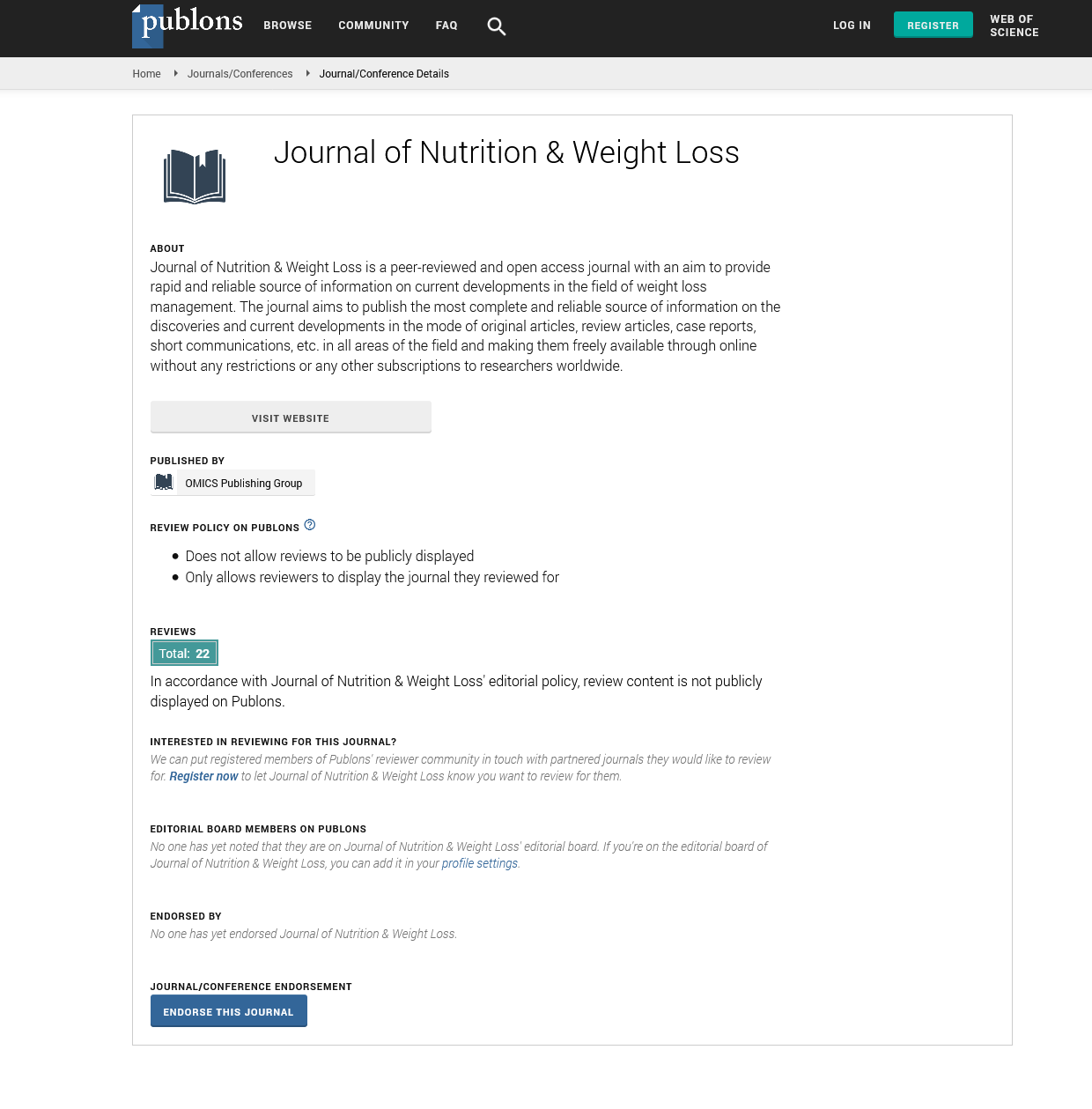Indexed In
- RefSeek
- Hamdard University
- EBSCO A-Z
- Publons
- Euro Pub
- Google Scholar
Useful Links
Share This Page
Journal Flyer

Open Access Journals
- Agri and Aquaculture
- Biochemistry
- Bioinformatics & Systems Biology
- Business & Management
- Chemistry
- Clinical Sciences
- Engineering
- Food & Nutrition
- General Science
- Genetics & Molecular Biology
- Immunology & Microbiology
- Medical Sciences
- Neuroscience & Psychology
- Nursing & Health Care
- Pharmaceutical Sciences
Short Communication - (2024) Volume 9, Issue 2
Impact of Ultra-Processed Foods on Weight Gain and Obesity
Mary Anderson*Received: 29-May-2024, Manuscript No. JNWL-24-27989; Editor assigned: 31-May-2024, Pre QC No. JNWL-24-27989 (PQ); Reviewed: 14-Jun-2024, QC No. JNWL-24-27989; Revised: 21-Jun-2024, Manuscript No. JNWL-24-27989 (R); Published: 28-Jun-2024, DOI: 10.35248/2593-9793.24.9.213
Description
Ultra-Processed Foods (UPFs) have become a dominant feature of modern diets, significantly contributing to the rising prevalence of weight gain and obesity worldwide [1]. These foods, characterized by their high degree of industrial processing, are designed to be convenient, palatable and often inexpensive. However, their nutritional profile and physiological effects on the body pose significant challenges for maintaining a healthy weight and metabolic balance.
One of the key factors linking UPFs to weight gain is their high caloric density combined with low nutritional value [2,3]. UPFs typically contain excessive amounts of added sugars, unhealthy fats and refined carbohydrates while being low in dietary fiber, protein and essential nutrients. This imbalance promotes overconsumption of calories, as these foods fail to provide the satiety and nutritional satisfaction necessary to regulate hunger effectively. Furthermore, their hyper-palatable nature-achieved through the addition of artificial flavors, sweeteners and other additives-can lead to compulsive eating behaviors, further exacerbating caloric overconsumption [4].
The rapid digestion and absorption of nutrients from UPFs also play a role in their impact on weight. Refined carbohydrates and added sugars in these foods cause quick spikes and subsequent drops in blood glucose levels, triggering cycles of hunger and overeating. The lack of dietary fiber in UPFs means that these foods do not slow gastric emptying or stimulate satiety hormones, resulting in reduced feelings of fullness and increased calorie intake over time [5].
The consumption of UPFs is closely associated with changes in hormonal regulation that contribute to obesity [6]. These foods disrupt the balance of leptin and insulin, two hormones critical for energy homeostasis. Leptin, produced by adipose tissue, signals the brain to reduce hunger when energy stores are sufficient. However, diets high in UPFs can lead to leptin resistance, a condition in which the brain no longer responds appropriately to leptin’s signals, promoting persistent hunger and weight gain. Similarly, chronic consumption of UPFs can impair insulin sensitivity, increasing the risk of type 2 diabetes and further complicating weight management [7,8].
In addition to their direct metabolic effects, UPFs contribute to weight gain through their impact on gut health. The gut microbiome, a diverse community of microorganisms in the digestive tract, plays a pivotal role in nutrient metabolism, immune function and appetite regulation. Diets high in UPFs have been shown to reduce microbial diversity and promote the growth of pathogenic bacteria, leading to dysbiosis. This imbalance in the gut microbiome is associated with increased inflammation, altered energy metabolism and a greater propensity for fat storage, all of which contribute to obesity.
Behavioral and environmental factors also reduce the impact of UPFs on weight gain [9]. These foods are often marketed aggressively, particularly to children and adolescents, creating a strong preference for unhealthy eating patterns from an early age. Their convenience and long shelf life make them a staple in busy households, where time constraints and limited access to fresh, whole foods may drive reliance on UPFs. Social and economic factors, such as food deserts and the affordability of UPFs compared to healthier options, further perpetuate their consumption among vulnerable populations.
Addressing the role of UPFs in obesity requires both individual and systemic interventions. At the individual level, increasing awareness of the health risks associated with UPFs and promoting healthier dietary choices are essential. Strategies such as meal planning, cooking at home and incorporating more whole, minimally processed foods into the diet can help reduce reliance on UPFs. Public health initiatives, including nutritional education programs and clear labeling of food products, can empower consumers to make informed decisions about their dietary habits [10].
Policy measures also play a critical role in reducing the consumption of UPFs and their impact on obesity. Governments and regulatory bodies can implement taxes on sugar-sweetened beverages and other UPFs to discourage their purchase and consumption. Subsidies for fresh produce and whole foods can make healthier options more accessible and affordable for all socioeconomic groups. Restricting the marketing of UPFs to children and implementing standards for school meals can further mitigate their influence on dietary patterns and weight outcomes.
Conclusion
In conclusion, the pervasive presence of UPFs in modern diets presents a formidable challenge for combating obesity. Their widespread availability, addictive properties, and detrimental effects on metabolic health make them a significant driver of weight gain and associated chronic diseases. By addressing both individual behaviors and systemic factors that promote the consumption of UPFs, it is possible to curb their impact on global obesity trends and improve overall public health outcomes.
References
- Monteiro CA, Cannon G, Levy RB, Moubarac JC, Louzada ML, Rauber F, et al. Ultra-processed foods: What they are and how to identify them. Public Health Nutr. 2019;22(5):936-41.
[Crossref] [Google Scholar] [PubMed]
- Hall KD, Ayuketah A, Brychta R, Cai H, Cassimatis T, Chen KY, et al. Ultra-processed diets cause excess calorie intake and weight gain: An inpatient randomized controlled trial of ad libitum food intake. Cell Metab. 2019;30(1):67-77.
[Crossref] [Google Scholar] [PubMed]
- Crimarco A, Landry MJ, Gardner CD. Ultra-processed foods, weight gain, and co-morbidity risk. Curr Obes Rep. 2021;11(3):80-92.
[Crossref] [Google Scholar] [PubMed]
- Gomez-Delgado F, Torres-Peña JD, Gutierrez-Lara G, Romero-Cabrera JL, Perez-Martinez P. Artificial sweeteners and cardiovascular risk. Curr Opin Cardiol. 2023;38(4):344-51.
[Crossref] [Google Scholar] [PubMed]
- Andriessen C, Fealy CE, Veelen A, Van Beek SM, Roumans KH, Connell NJ, et al. Three weeks of time-restricted eating improves glucose homeostasis in adults with type 2 diabetes but does not improve insulin sensitivity: A randomised crossover trial. Diabetologia. 2022;65(10):1710-20.
[Crossref] [Google Scholar] [PubMed]
- Asensi MT, Napoletano A, Sofi F, Dinu M. Low-grade inflammation and ultra-processed foods consumption: A review. Nutrients. 2023;15(6):1546.
[Crossref] [Google Scholar] [PubMed]
- Janssen JA. Ultra-processed foods and type 2 diabetes: More fundamental research is needed. Lancet Reg Health Eur. 2024;46:101084.
[Crossref] [Google Scholar] [PubMed]
- Elizabeth L, Machado P, Zinöcker M, Baker P, Lawrence M. Ultra-processed foods and health outcomes: A narrative review. Nutrients. 2020;12(7):1955.
[Crossref] [Google Scholar] [PubMed]
- Cordova R, Kliemann N, Huybrechts I, Rauber F, Vamos EP, Levy RB, et al. Consumption of ultra-processed foods associated with weight gain and obesity in adults: A multi-national cohort study. Clin Nutr. 2021;40(9):5079-88.
[Crossref] [Google Scholar] [PubMed]
- Gibney MJ, Forde CG, Mullally D, Gibney ER. Ultra-processed foods in human health: A critical appraisal. Am J Clin Nutr. 2017;106(3):717-24.
[Crossref] [Google Scholar] [PubMed]
Citation: Anderson M (2024). Impact of Ultra-Processed Foods on Weight Gain and Obesity. J Nutr Weight Loss. 9:213.
Copyright: © 2024 Anderson M. This is an open access article distributed under the terms of the Creative Commons Attribution License, which permits unrestricted use, distribution, and reproduction in any medium, provided the original author and source are credited.


